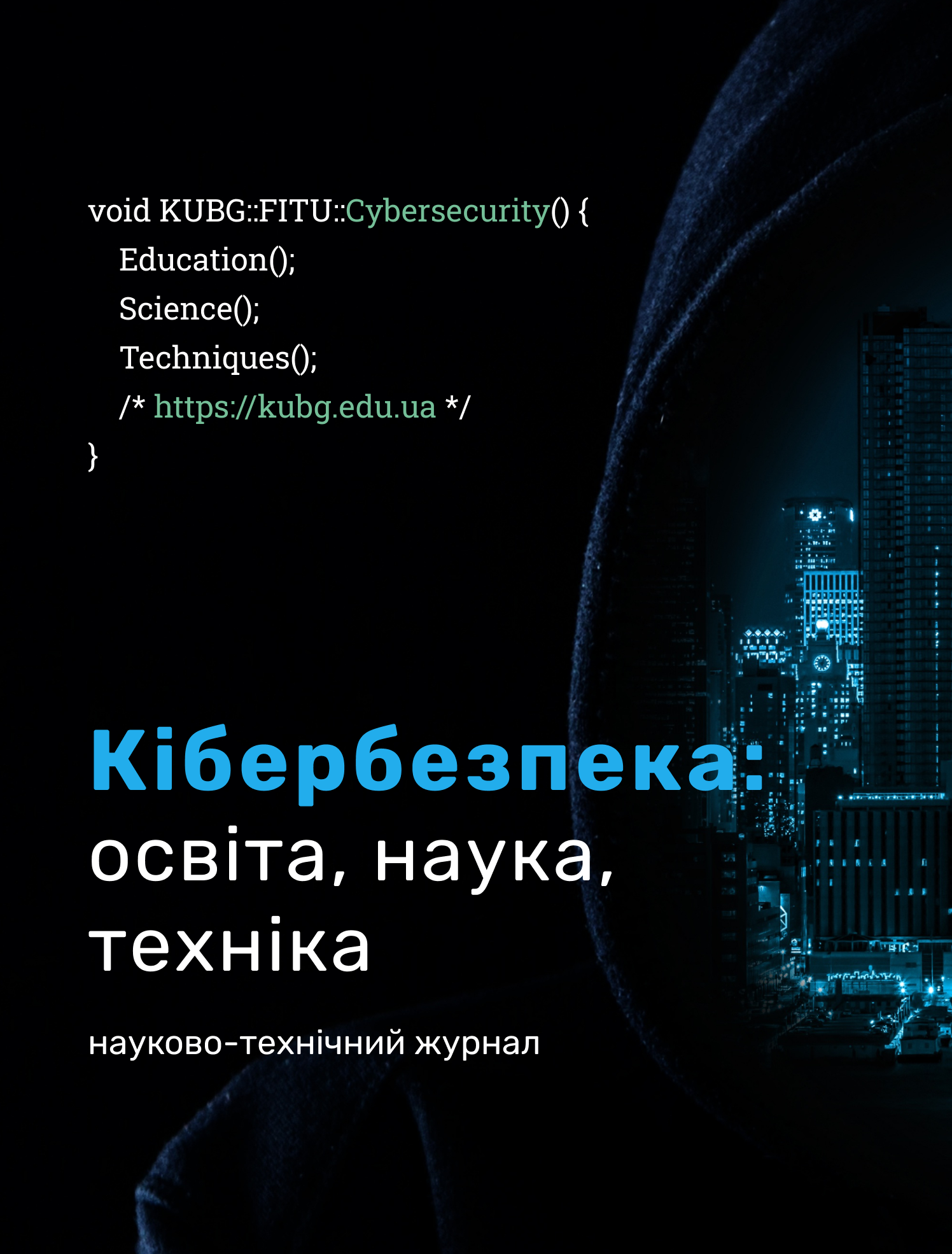CLUSTER ANALYSIS FOR RESEARCHING DIGITAL FOOTPRINTS OF STUDENTS IN EDUCATIONAL INSTITUTIONS
DOI:
https://doi.org/10.28925/2663-4023.2024.23.3141Keywords:
digital traces; cluster analysis; digital educational environment of the educational institution; informational security.Abstract
It is shown that Cluster Analysis (CA) can be used in the process of researching the Digital Traces (DT) of students of an educational institution, as well as other educational institutions that introduce a Digital Educational Environment (DEE) into the educational process. Cluster analysis can reveal behavioral patterns of education seekers. Also, the use of CA methods will improve the personalization of training and increase the effectiveness of educational programs. It is shown that in the context of ensuring Information Security (IS) of the DEE of educational institutions, technologies and methods of DT analysis can also be useful, for example, for: monitoring students’ network activity; analysis of student authorization and authentication logs; detection of malicious programs and attacks on the DEE; analysis of IS threats to the DEE as a whole; vulnerability prediction. It is shown that the application of CA methods can be useful in studying the degree of information security of the DEE of universities and other educational institutions. It has been established that CA methods can help identify groups of students with similar patterns of activity from the point of view of IS, both the DEE of the educational institution as a whole, and its computer networks and systems. It has been established that with the help of CA DT, it is possible to detect anomalous behavior of students, to detect unusual patterns of activity, facts of unauthorized use of resources or other deviations from the typical behavior of students in the network of the educational institution. The article also provides the results of experimental studies of the level of competences of students of various specialties at the university in IS and protection of information assets of the DEE. In this, CA methods were used in the process of studying students’ DT. Six types of users were distinguished on the basis of CA DT of different groups of students registered in the university DEE. As a result of the application of CA methods, students registered in the university’s DEE were divided into appropriate clusters according to criteria affecting IS risks.
Downloads
References
Oliveira, P., Cunha, C., & Nakayama, M. (2016). Learning Management Systems (LMS) and E-learning Management: An Integrative Review and Research Agenda. JISTEM-J. Inf. Syst. Technol. Manag. 13, 157–180.
Aldiab, A., et al. (2019). Utilization of Learning Management Systems (LMSs) in Higher Education System: A Case Review for Saudi Arabia. Energy Procedia, 160, 731–737. https://doi.org/10.1016/j.egypro.2019.02.186
Azcona, D., Hsiao, I., & Smeaton, A. (2019). Detecting Students-at-Risk in Computer Programming Classes with Learning Analytics From Students’ Digital Footprints. User Modeling and User-Adapted Interaction, 29, 759–788. https://doi.org/10.1007/s11257-019-09234-7
Nai, R., et al. (2023). Process Mining on Students’ Web Learning Traces: A Case Study with an Ethnographic Analysis. European Conference on Technology Enhanced Learning, Lecture Note in Computer Science, 14200, 599–604. https://doi.org/10.1007/978-3-031-42682-7_48
Mohssine, B., et al. (2021). Adaptive Help System Based on Learners ‘Digital Traces’ and Learning Styles. Int. J. Emerging Technol. Learning (iJET), 16(10), 288–294. https://doi.org/10.3991/ijet.v16i10.19839
Ye, D., & Pennisi, S. (2022). Using Trace Data to Enhance Students’ Self-Regulation: A Learning Analytics Perspective. The Internet and Higher Education, 54, 100855. https://doi.org/10.1016/j.iheduc.2022.100855
Noskova, T., Pavlova, T., & Yakovleva, O. (2018). Study of Students’ Educational Activity Strategies in the Social Media Environment. E-learning and Smart Learning Environment for the Preparation of New Generation Specialists, 10, 113–125.
Kadoić, N., & Oreški, D. (2018). Analysis of Student Behavior and Success Based on Logs in Moodle. 2018 41st International Convention on Information and Communication Technology, Electronics and Microelectronics (MIPRO). https://doi.org/10.23919/MIPRO.2018.8400123
Mogus, A., Djurdjevic, I., & Suvak, N. (2012). The Impact of Student Activity in a Virtual Learning Environment on Their Final Mark. Active Learning in Higher Education, 13(3), 177–189. https://doi.org/10.1177/1469787412452985
Stiller, K., & Bachmaier, R. (2018). Identifying Learner Types in Distance Training by Using Study Times. EDEN Conference Proceedings, 1, 78–86.
Ahmed, A., Alharthe, R., & Alfereej, M. (2023). Organizational Committees and Their Role in Enhancing Intellectual Security: A Case Study on Female Students of the Bachelor of Information Science Program-College of Arts-Imam Abdul Rahman bin Faisal University. Library Philosophy and Practice, 1–26.
Cheung, S. (2014). Information Security Management for Higher Education Institutions. Intelligent Data analysis and its Applications, Volume I. Advances in Intelligent Systems and Computing, 297, 11–19. https://doi.org/10.1007/978-3-319-07776-5_2
Al Quhtani, M. (2017). Data Mining Usage in Corporate Information Security: Intrusion Detection Applications. Business Systems Research. International journal of the Society for Advancing Innovation and Research in Economy, 8(1), 51–59. https://doi.org/10.1515/bsrj-2017-0005
Salem, I., et al. (2022). Introduction to The Data Mining Techniques in Cybersecurity. Mesopotamian J. Cybersecur. 2022, 28–37. https://doi.org/10.58496/MJCS/2022/004
Kong, J., et al. (2021). Deep-stacking Network Approach by Multisource Data Mining for Hazardous Risk Identification in IoT-based Intelligent Food Management Systems. Computational Intelligence and Neuroscience, 202. https://doi.org/10.1155/2021/1194565.
Mathew, A. (2023). The Power of Cybersecurity Data Science in Protecting Digital Footprints. Cognizance J. Multidisciplinary Studies, 3(2), 1–4. https://doi.org/10.47760/cognizance.2023.v03i02.001
Muhammad, S., Dey, B., & Weerakkody, V. (2018). Analysis of Factors That Influence Customers’ Willingness to Leave Big Data Digital Footprints on Social Media: A Systematic Review of Literature. Inf. Syst. Frontiers, 20, 559–576. https://doi.org/10.1007/s10796-017-9802-y
Cheng, F., & Wang, Y. (2018). The do Not Track Mechanism for Digital Footprint Privacy Protection in Marketing Applications. J. Bus. Econom. Manag. 19(2), 253–267. https://doi.org/10.3846/jbem.2018.5200
Published
How to Cite
Issue
Section
License
Copyright (c) 2024 Валерій Лахно, Семен Волошин, Сергій Мамченко, Олег Кулініч , Дмитро Касаткін

This work is licensed under a Creative Commons Attribution-NonCommercial-ShareAlike 4.0 International License.




